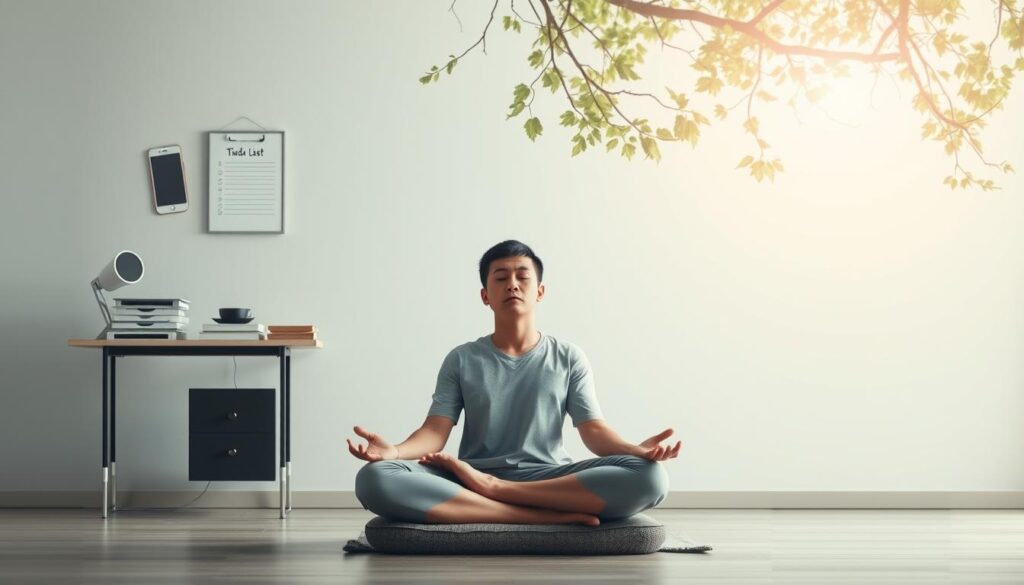A lot of people suffer from neck pain, which can really lower their comfort and quality of life. Mindfulness exercises are now seen as a good way to help ease neck pain. They focus on reducing stress and managing pain better.
By adding these exercises to your daily life, you can learn to relax more. This could help you deal with neck pain in a more effective way.
Understanding Neck Pain and Its Impact
Many people face a tough challenge with chronic neck pain. It often comes from things like bad posture, stress, and injuries. These issues lead to long-lasting discomfort that messes with everyday life and happiness.
Neck pain does more than just hurt physically. It makes people less productive and more likely to feel upset or worried. Studies show it’s one of the top five chronic pains worldwide, creating big problems for both individuals and society.
It’s key to know about neck pain and how it affects lives. Taking steps to manage pain helps improve both the body and mind. By getting to know the causes and impacts of neck pain, people can find treatments that really help.
What is Mindfulness?
The mindfulness definition means being fully aware of the now. It’s about noticing thoughts and feelings without judging them. This awareness lets people really connect with what’s around them and what they’re feeling inside. A good mindfulness practice can include breathing exercises, meditation, and paying close attention to feelings or sensations.
Practicing mindfulness often brings many benefits of mindfulness. People tend to feel less stressed, manage their emotions better, and feel a stronger link between their body and mind. This way of living helps people face daily issues calmly and stay peaceful even when things get tough.
Mindfulness Exercises to Reduce Neck Pain
Mindfulness exercises designed for neck pain offer big benefits. These exercises can ease discomfort and deepen relaxation. People often feel less pain and more emotional wellness. They learn to be mindfully aware, treating their pain with kindness.
Benefits of Mindfulness for Neck Pain
Research shows mindfulness has key benefits for easing pain. It can
- Decrease muscle tension in the neck and shoulders.
- Improve posture through better body awareness.
- Boost stress coping skills, which helps with pain.
- Promote relaxation, making pain feel less intense.
How Mindfulness Affects the Nervous System
It’s key to know how mindfulness and the nervous system work together for neck pain. Mindfulness calms our system, helping heal and reduce stress responses. By being mindful, one can
- Lower anxiety and stress, reducing neck pain.
- Help muscles recover through relaxation responses.
- Improve mental clarity, leading to mindful daily living.
Swimming as a Mindfulness Exercise
Swimming is a fantastic way to practice mindfulness. It gets your whole body moving with less strain on your joints. When you move with focus in the water, you breathe in sync with your motions. This helps your mind break away from daily worries. It not only makes you more mindful but also helps you relax and keeps you fit.
Connecting Movement with Breath
To make swimming a mindful activity, link each stroke with your breath. This matching creates a soothing rhythm. It eases your mind into deep relaxation. By paying attention to your body’s movement in water, swimming becomes a meditative practice.
Benefits of Immersion in Water
Swimming has many perks for both your mind and body. Being in water lowers muscle stiffness, makes you more limber, and helps you unwind. As you swim, the water hugs your body, making you more mindful and present. This kind of mindful swimming can lift your spirits, lessen stress, and boost your happiness.
Medidative Walking for Neck Relief
Meditative walking is a great way to reduce neck pain and become more mindful. By walking slowly and focusing on the present, you can notice how your body moves. This helps you relax and feel more in tune with your body, which is good for easing neck tension.
Slowing Down and Being Present
To get the most out of walking, pay close attention to it. Slowing down turns a simple walk into a calming experience. Focus on how you breathe and move.
Feel the ground under your feet and how you balance with each step. This mindful walking makes you more aware of your body. You’ll notice your neck and shoulders loosening up as you walk this way.
How to Practice Core Walking
To start core walking, find a quiet place to walk without interruptions. Here are the steps:
- Stand tall, feet hip-width apart, and be fully present.
- Breathe in slowly, letting your belly expand, then breathe out softly.
- When walking, think about your legs moving and your weight shifting.
- Let your arms swing easily by your side.
- Keep focusing on your breathing, matching it with your steps.
This core walking method increases relaxation and awareness of your body. It’s a great way to understand how to ease neck pain. It turns walking into a key part of being healthy.
Drinking a Cup of Tea as Mindfulness Practice
Adding tea mindfulness to your day is a simple but powerful way to be mindful. It lets you slow down and enjoy making and drinking tea. This ritual helps you appreciate the smells, colors, and feels, connecting you to now.
Tea has many benefits, like helping you relax and calm down. By paying attention to the tea’s sensory details, your mind can calm down. This helps reduce stress and can ease neck pain by lowering overall stress.
- Choose your favorite tea.
- Boil fresh water and enjoy the bubbling sounds.
- Watch the tea leaves’ color as they steep.
- Smell the aroma spreading in the air.
- Drink your tea slowly, tasting every sip.
Following these steps in your tea time makes a space for clear thinking and calm. You’ll feel the good things tea brings into your life.
Connecting with Nature Through Hiking
Hiking is a great way to enhance mindfulness and connect with nature. It helps us to be fully present and enjoy nature’s benefits. Being outside and hiking reduces stress by offering physical and mental health perks.
Benefits of Nature for Reducing Stress
Being outdoors is perfect for relaxing and feeling rejuvenated. Research has found that being in nature helps by:
- Lowering stress hormone levels
- Improving mood and emotional well-being
- Boosting focus and mental clarity
Walking in peaceful places lets people dive into nature’s beauty. This deeply reduces stress.
Promoting Sensory Awareness
Hiking makes us use our senses, like hearing leaves or feeling the ground. This improves mindfulness by letting hikers:
- Notice the small changes around them
- Enjoy the beauty of plants and animals
- Be fully in the moment
This awareness greatly enhances the benefits of hiking, both for our bodies and minds.
Gazing Meditation: Focused Mindfulness
Gazing meditation is a key way to practice focused meditation. It lets you focus on a specific object for mindfulness. This method helps in achieving deep concentration. It also brings a peaceful mind, making it easier to deal with pain.
Selecting Your Focus Object
Finding the right object is important for a good gazing meditation. There are different things that can make your meditation better. Here’s how to pick something to focus on:
- A candle flame, offering a warm and steady light.
- A natural element, such as a flower or leaf, which connects you to the earth.
- An image or symbol that resonates personally, inspiring positive emotions.
- Your breath, using it as the focal point can ground you in the moment.
When doing gazing meditation, keep your attention on your chosen object. This helps you relax deeper and think clearer. This makes focused meditation even more beneficial.
Guided Meditation for Neck Pain Relief
Guided meditation is a great way to deal with neck pain. It uses different techniques to help you relax and ease stress. A key technique is Yoga Nidra, which lets you deeply relax while still being awake. This helps your body heal itself, especially around the neck.
Adding guided meditation to your daily life can make a big difference in how you feel. It has these benefits:
- It makes you more aware of how you experience pain.
- It helps loosen tight muscles, relaxing your body.
- It clears your mind, which helps you handle pain better.
Pairing meditation with ways to release stress, like imagining peaceful scenes and breathing deeply, makes it even more effective. This helps create a calm state of mind. It changes how you feel pain, giving you more power over your body. Meditation teaches you to stay calm under stress, which helps you handle both physical pain and emotional stress better.
Stretching Techniques for Mindfulness
Mixing mindfulness with physical stretching can boost awareness of your body. It helps you relax. Gentle stretches, particularly for the neck, help ease pain while allowing for better breathing. This creates a stronger bond with your body.
Gentle Stretching Practices
Adding gentle stretches to your daily activities can make you more mindful. These might include:
- Neck tilts to release tension
- Shoulder rolls to increase mobility
- Seated forward bends to elongate the spine
While doing these stretches, pay attention to how your body feels. Being mindful during stretching makes the experience better and eases discomfort.
Creating Space for Breath
Breathing right is key during mindfulness stretching. Using proper breathing with stretching helps:
- Deeper breaths that make your chest bigger
- Breaths out that help you relax
- A slower pace that makes you more mindful
Combine your breaths with your movements while stretching. This links your mind and body closely. It increases body awareness and eases pain.
Breathing Techniques to Alleviate Pain
Breathing techniques help manage discomfort by promoting relaxation and reducing stress. Diaphragmatic breathing stands out because it encourages deeper breathing. It calms the nervous system and helps the body handle pain better.
The Role of Diaphragmatic Breathing
Diaphragmatic breathing is also known as abdominal or belly breathing. It has many benefits for managing pain. By focusing on deep breaths, it activates the parasympathetic nervous system. This creates a relaxation state essential for easing pain.
- Enhances oxygen flow throughout the body
- Slows down the heart rate, promoting calm
- Reduces tension in muscles
- Supports emotional regulation, which is crucial for pain tolerance
Adding these breathing techniques to daily routines can greatly improve well-being and pain management. Diaphragmatic breathing is a powerful tool for those seeking pain relief. It is effective in moments of discomfort or as a preventive approach.
Challenges in Maintaining a Mindfulness Practice
Starting a mindfulness practice comes with challenges that can slow you down. You might find your mind wandering due to distractions around you or even your own thoughts. Figuring out what causes these distractions can help you focus better.
Finding enough time is a big problem for many people. With so much going on every day, it’s tough to find a moment for mindfulness. But setting aside just a little time each day can make a big difference.
Sometimes, mindfulness can bring up strong emotions, leading to frustration or the urge to give up. It’s important to see these emotions as part of the journey. Being kind and patient with yourself is key to moving forward.
Here are some strategies to address these mindfulness challenges:
- Set a specific time each day for mindfulness activities to integrate them into your routine.
- Try shorter sessions of mindfulness to gradually build comfort and consistency.
- Create a dedicated space for practice that is free from distractions.
- Incorporate mindfulness techniques into daily activities, such as standing in line or waiting for appointments.

Conclusion
This article looked at different ways to reduce neck pain using mindfulness. We discussed activities like swimming and walking mindfully. These can help ease your pain and make you feel better emotionally.
Mindfulness helps you pay more attention to your body and breath. This approach can improve your neck’s health overall.
Adopting mindfulness does more than ease pain; it improves your life. By practicing regularly, you can lessen your stress and feel calmer. These methods are key for your well-being.
Mindfulness can really help with neck pain and boost your overall health. Why not try it out? Find the techniques that work best for you. Start your journey to a happier, healthier life today.



